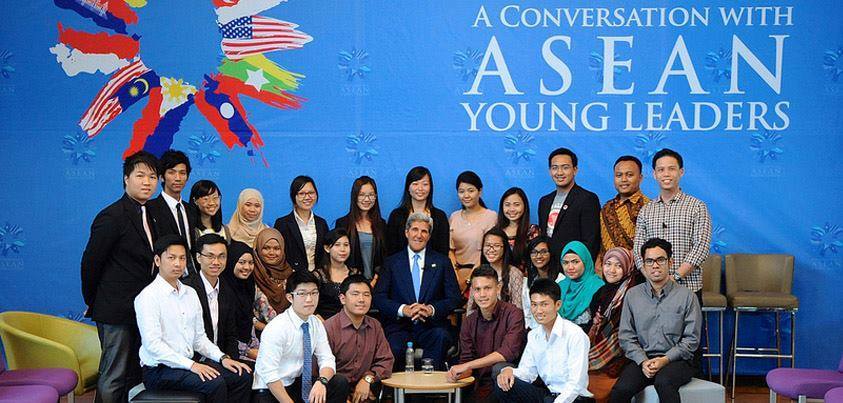 Picture from https://yesalumnimalaysia.wordpress.com/2013/10/21/lead-asean-youth-pre-summit-by-luqman-ramli/ Picture from https://yesalumnimalaysia.wordpress.com/2013/10/21/lead-asean-youth-pre-summit-by-luqman-ramli/ Better Engaging ASEAN's Youth: Taking A Leaf from Obama's Playbook ASEAN (Association of Southeast Asian Nations) has a young population with 65% under 35 years old – that is over 400 million out of 620 million ASEAN citizens. Hence, youth should be a top priority for these member states. From my observation, the U.S. has been more effective than ASEAN itself in engaging youth through its Young Southeast Asian Leaders Initiative (YSEALI). With the establishment of ASEAN Community in 2015, ASEAN can take a leaf from America’s book in forging ahead together to 2025. Youth falls under ASEAN’s Socio-Cultural Community. Every year, the ASEAN Ministerial Meeting on Youth (AMMY) is held to decide the direction and coordinate policy in youth development.[1] However, the awareness of these outcomes or AMMY itself is low as information is difficult to find. Nonetheless, youth in ASEAN are dynamic and vibrant. Evidently, there is a number of prominent non-governmental organisations (NGOs) and initiatives – ASEAN Youth Organization (AYO), ASEAN Young Professionals Network and ASEAN Youth Leaders’ Association (AYLA) to name a few. However, its impact tends to be confined to their respective countries due to challenges in resources and geography. It’s safe to say there is no single entity dedicated for youth development in all member states until the emergence of YSEALI. YSEALI is US President Barack Obama’s signature program to develop emerging leaders from ASEAN. Run by the US State Department, its network has grown in excess of 55,000 members in the span of only 3 years since its inception in 2013.[2] Close to 2,000 youth leaders have participated in YSEALI’s initiatives: academic and professional fellowship; regional workshops; and grants competition.[3] Ironically, the US has been more successful than ASEAN in uniting and training youth leaders through its regional exchange programs. President Obama himself has directly engaged ASEAN youths in town halls in Malaysia in 2014 and 2015. With YSEALI’s success, I believe youth in ASEAN are more aware of this American leadership initiative than ASEAN’s own youth programs. Based on the case study of YSEALI, I would like to propose the following three ideas: 1. ASEAN Youth Fellowship The fellowship aims to train a generation of young leaders with the ASEAN experience. Fellows will have the opportunity to visit the ASEAN countries to learn and appreciate its issues, politics, culture and history. The visit includes dialogue sessions between the fellows and ASEAN leaders. The fellowship consists of training seminars, site visits and the annual ASEAN Youth Summit. Emphasis is given on knowledge sharing, networking and capacity-building. As with Obama’s YSEALI, the fellowship will need the strong backing of the ASEAN leaders to fund and coordinate between among the 10 member states. 2. ASEAN youth incubator The youth incubator acts an enabler for aspiring leaders to develop their leadership skills. The incubator can co-design a youth “accelerator” program with the ASEAN ministries of youth. Participants can develop key skills from experts and benefit from insights from leaders from government, corporate and civil society in ASEAN. They will be mentored to design and deliver community projects in various fields (e.g. education, human rights, environment). The incubator can also run a virtual portal to compile and disseminate all information and opportunities for youth in the region. Partnerships with ministries of youth and corporate companies will be crucial to ensure the incubator’s success. 3. ASEAN Youth Assembly Taking a step beyond YSEALI, ASEAN can look into establishing the “ASEAN Youth Assembly” whereby elected youth representatives from member states deliberate on regional issues encompassing the three pillars of ASEAN. The framework of the Assembly can be modeled after the Malaysian Youth Parliament in which members are elected for a two-year term. [4] The Assembly will convene in an ASEAN capital city for three days of seating to be chaired by the youth delegate from the host ASEAN member. The secretariat may appoint representatives to promote diversity. The representatives will be assigned to select committees to debate on relevant motions. The output from the seating will be presented to AMMY for endorsement. The collective voice of the ASEAN representatives fosters ownership and unity amongst youth. Ultimately, youth need be involved and contribute to the decision-making process, as these decisions will impact them being the majority of the population. ASEAN has made significant progress in developing the region since 1967. As it moves towards building a socially responsible and people-centred ASEAN in 2025, the Association has to acknowledge new challenges faced by youth will need fresh ideas. With a predominantly young population, ASEAN leaders need to systematically encourage youth to participate in its decision-making process. Only when ASEAN youth are engaged can ASEAN realise its true potential as a regional powerhouse. [1] ASEAN Ministerial Meeting on Youth (AMMY): http://www.asean.org/asean-socio-cultural/asean-ministerial-meeting-on-youth-ammy/ [2] The White House, Fact Sheet: The President's Young Southeast Asian Leaders Initiative, 20 Nov 2015, https://www.whitehouse.gov/the-press-office/2015/11/20/fact-sheet-presidents-young-southeast-asian-leaders-initiative [3] Young Southeast Asian Leaders Initiative (YSEALI): https://www.whitehouse.gov/the-press-office/2015/11/20/fact-sheet-presidents-young-southeast-asian-leaders-initiative [4] Azwan bin Omar, ‘Stronger ASCC, Closer ASEAN’, ERIA-GOM International Symposium on Stronger ASCC, Closer Asean, Grand Hyatt Kuala Lumpur, Malaysia, 16th November 2015.
0 Comments
Leave a Reply. |
Categories
All
Archives
May 2024
|
 RSS Feed
RSS Feed
